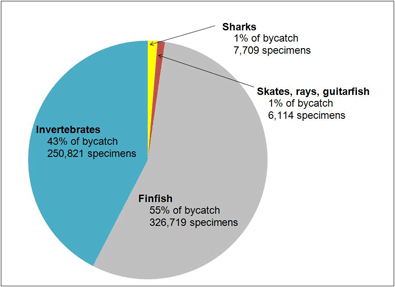Methods - Bycatch processing procedures

A veterinary student from NC State University sorts the by-catch from a typical 30-minute turtle net trawl prior to cataloguing what was captured in each of the port and starboard nets.
Fish and invertebrates (i.e., bycatch) are identified and various data recorded for all trawling events completed each season. Bycatch data are recorded separately for each of the two trawl nets used in this survey. The first step in recording bycatch data is to sort through the catch and group similar animals together, so that their abundance in the trawl collection can be recorded. Additional data such as the sex of the animal or its body length is also recorded for sharks, rays, and other commercially and recreationally important species.
Trawling with turtle nets in open coastal waters between St. Augustine, FL and Winyah Bay, SC, captured 591,363 bycatch specimens through 2011. At a total of 4,756 trawling events for this data set, that is an average of 124 bycatch animals captured per event.
Only 2% of bycatch animals have been sharks, skates, rays, and guitarfish. Eighty-nine percent of all shark captures have consisted of Atlantic sharpnose and bonnethead sharks which typically measure less than three feet in length, although occasionally larger sizes are encountered, most commonly blacktip and nurse sharks. Dasyatid stingrays and butterfly rays, which generally measure less than two feet in body width, have constituted 85% of ray captures.

Personnel from SCDNR carefully examine the portside net prior to opening it and safely releasing the large black tip shark and other specimens that were collected.
Forty-three percent of bycatch data are associated with invertebrate animals. One hundred ninety listings have been recorded, with the top 10 listings accounting for 80% of all invertebrate bycatch and the top listing accounting more than a third (39%) of all invertebrate captures. In decreasing order, the top 10 invertebrate bycatch animals are cannonball jellyfish, gray sea star, box jellyfish, sea nettles, short-spine urchins, long-spine urchins, spider crabs, common sea stars, miscellaneous tunicates, and banded sea stars.
Fifty-five percent of bycatch data are associated with finfish. One hundred seventy-nine listings have been recorded, with the top 10 listings accounting for 90% of all finfish catch and the top listing accounting for nearly half (47%) of all finfish captures. In decreasing order, the top 10 finfish caught are Atlantic bumper, Atlantic moonfish, banded drum, longspine porgy, Atlantic spadefish, harvestfish, northern sea robin, butterfish, striped burrfish, and spot.

A pie chart showing the relative composition of non-sea turtle catch in the regional trawl survey between 2000 and 2011. Sharks, skates, and rays represent just 2% of the nearly 600,000 specimens catalogued in the past decade, which consists mostly of finfish and invertebrate creatures.
The presence of species indicative of hard bottom habitats is also used to characterize the seafloor where trawling occurred as hard bottom, probable hard bottom, or not hard bottom. Most trawling (i.e., 54% ±9%) has been conducted over seafloor characterized as not hard bottom based on the absence of any of 54 fish or invertebrate indicator species [4 , 5]. The remainder of trawling has been nearly equally split between probable (1 or 2 indicator species) and hard (≥3 indicator species) bottom.
4 Reed, J.K. 2004. General description of deep-water coral reefs of Florida, Georgia and South Carolina: A summary of current knowledge of the distribution, habitat, and associated fauna. A Report to the South Atlantic Fishery Management Council, NOAA, NMFS, 71p.
5 VanDolah, R., P. Maier, G. Sedberry, C. Barans, F. Idris, and V. Henry. 1994. Distribution of bottom shelf habitats on the continental shelf off South Carolina and Georgia. Final Report submitted to Southeast Area Monitoring and Assessment Program South Atlantic Committee.
